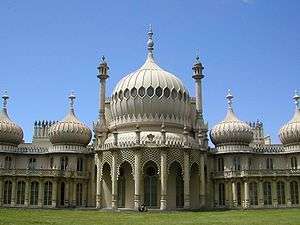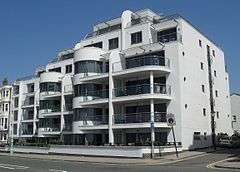Regency Town House
The Regency Town House is a Grade I listed historic townhouse,[2] now a museum, in Brunswick, an area of Hove in Brighton & Hove, England. The house is being restored by a team headed by Curator Nick Tyson.[3]


In 1984 Nick Tyson decided to reassemble a whole 1829 terraced house in Hove's Brunswick Square. He first bought the basement flat. Then he bought the remaining flats as the other tenants left. He plans to restore the building as authentically as possible. Every detail will be restored authentically. It will be opened to the public. The period craftsmanship will be showcased this way.[1]
Nick Tyson, a conservationist, founded the Town House in the 1980s. After his architectural awakening in the USA, he observed that Brighton and Hove's historic buildings were being converted with little care and attention, which concerned him. Nick and partner bought the lease of an uninhabitable basement flat at 13 Brunswick Square and decided to take a year out to restore it before returning to the States. However, leases of the other flats began to become available and Nick could see the possibility of putting the house back together again – a dream in the making.[4] It is a passion project for him. The building started as flats and is now an almost complete house again. The restoration work is in full swing and uses traditional techniques and materials. The Town House is being returned to its former glory with the help of a team of volunteers. It is being slowly and carefully restored. Every tour and event which raises money means funds for more restoration.[5]

Layers of peeling paint have been removed. The mouldings and plasterwork had been expertly repaired. Analysis has been carried out on finishes original to the property. This information can be used to recreate decoration in other parts of the project. The goal is to offer complete access to all rooms in the house as to have them appear to guests as they would have when the house was first occupied.[5]
There is a dining room and a parlour on the ground floor. On the half-landing there is a waiting room and a water-closet. On the first floor are the drawing rooms. These rooms could be used separately, by using folding doors, or as one large party space. The upper storeys had bedrooms. The basement was where the servants worked, with access from the front area and also behind through the stables.[6]
Part of The Regency Town House project is located at 10 Brunswick Square. This is the last intact basement in the square. It provides an insight into servant life.[1] If you were to visit you would walk down stairs from the street to a front basement area which has a stone-flagged floor. There is a coal cellar under the street which would have provided the fuel for the fireplaces upstairs. Next to the coal cellar is a beer cellar. The first right on the right is the housekeeper's room, next to this is the wine cellar. It has a double doors, the second is iron-lined. This acts as an extra precaution again theft from servants. Next is a servant's hall. Large in this house as there would have been 8-12 servants. The room overlooks a small courtyard. On the other side of this courtyard is the kitchen. It has a large skylight and it's said that its layout was influenced by the Prince Regent's famous kitchen at the Brighton Pavilion.[1]

The Regency Town House is located at 13 Brunswick Square near the beach in Hove. Brunswick Square forms part of Brunswick Town. It has two full-time members of staff. It also has a team of volunteers whose efforts are helping to transform the building into a museum and heritage centre.[7] The house was built in the 1820s.[2] It was designed in the Regency architectural style.[2] It holds regular fundraising activities including Dine Like a Servant.[8][9][10][11][12][13][14] It is also an exhibition venue and recently held an exhibition by the artist Suzanne O‘Haire.[15]
References
- Binney, Marcus (1998). Town Houses - Evolution and Innovation in 800 Years of Domestic Architecture. Great Britain: Mitchell Beazley. pp. 94, 95, 96, 97. ISBN 1840000295.
- Regency Town House, Brighton Festival
- "The house that Nick restored". The Argus. Retrieved 10 February 2019.
- "Elaine Evans interviews - Nick Tyson". Retrieved 3 April 2019.
- Seymour, Ellie (2018). Secret Brighton. Versailles, France: Jonglez Publishing - travel guides. pp. 122–123. ISBN 9782361952648.
- Antram, Morrice, Nicholas, Richard (2008). Brighton and Hove. New Haven and London: Yale University Press. p. 115. ISBN 9780300126617.
- Fergar, Ellis (26 June 2018). "A window into the past— Regency Town House Hove". Title Sussex Magazine. Retrieved 10 February 2019.
- Rosemary (1 February 2019). "Dine Like a Servant at The Regency Town House". Rosemary and Pork Belly. Retrieved 10 February 2019.
- "Regency Town House serves up period dinner". The Argus. Retrieved 10 February 2019.
- Richard Vobes, Bald Explorer Podcast: Dine Like A Servant at the Regency Town House, retrieved 10 February 2019
- "Dine Like A Servant | Brighton Info". interests.me. Retrieved 10 February 2019.
- Darren Menezes, Dine like a servant April 2018, retrieved 10 February 2019
- Darren Menezes, Halloween Dine like a Servant 31 Oct 2018, retrieved 10 February 2019
- Couchman, Paul. "How do you Dine Like A Servant? – Paul Couchman on Food and History". Retrieved 10 February 2019.
- "Visit to Suzanne O'Haire: Peck O' Trouble | Blue Monkey Network". Towner Art Gallery. Retrieved 13 February 2019.

.jpg)
.jpg)
